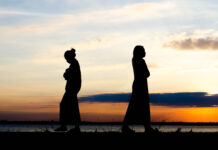Behind my mask of total incompetence,” I tell the lady who is helping me get my baby onto the Bituach Leumi national insurance—when it turns out that I need the kind of assistance usually rendered to small, broke countries—“I am actually disguising the fact that I am completely incompetent.”
The lady on the other end of the line tells me that I am not incompetent at all; it’s just that this is a country where they keep changing the rules because apparently that is something that lawmakers do here when they are feeling bored or when they want to seek revenge upon their enemies and their enemies are me. (I extrapolated that last part.) When I hang up the phone with her reassurances still ringing in my ears, I do feel better, mostly because I am thinking that here is a woman who could have remained faceless and anonymous. She could have said, “Sorry, applicant, but you did not fill out the correct stuff on form ABCDEFGsilentQ and therefore you must start from the beginning and also stand on your head and sing silly songs and I’m sorry but that’s just how it is. I don’t make the rules.”
Instead of just doing her job, she reached out to me, with assurances, with her name, to help.
It was a famous author who expressed the idea that it’s when you give someone a mask, that they show you their true face, and while the advent of social media and hiding behind anonymous screen names to bully and name-call does seem to prove this time and again in the negative, thankfully, it also holds true in the positive.
While searching for that famous author who articulated so well the idea of metaphorical masks and their real-life implications, I came across many fascinating articles about actual masks, some in use in the present day and some in the past, whose purposes boiled down to a few categories: disguise, ritual, safety, ornamentation, protection, and of course, entertainment. They share one thing in common: an awesome creep factor. Well, that, and the fact that they all serve to cover your face.
I have shared the best of the lot with you below.
Also: a word of warning. After researching perhaps a bit too enthusiastically for this article, my search engine is now under the impression that I am some sort of mask aficionado, so when I search for something like “footsies size 3-6 months” it asks me, “do you mean Chinese Opera Masks?” and first I tried to explain, “No, search engine, I obviously do not mean anything of the sort,” but then it showed me pictures of amazing masks and added ideas like, We think you will like the article, A Brief History of Venetian Masks, and at first I was offended because I think I know what I like, thank you very much, and right now I like clothing that my baby will fit into, but it turns out that ancient Egyptian death masks are admittedly more interesting than footsies of any size at all; so, well-played, Google. You win this round.
Also, a word about the current environment in my house: Having masks, especially horse-head masks, makes my kids 5000% more likely than usual to gallop through the house while wearing them and yell things like, “Please excuse my voice, just now I am a little horse,” and my husband is all, No child of mine will make such horrible puns, and I nod vehemently but beneath my mask of disapproval at their antics lies an expression of total approval.
So it’s probably my fault.
(Please send any and all awesome masks you might have and no longer need to Dina Neuman c/o Ami Magazine.)





















